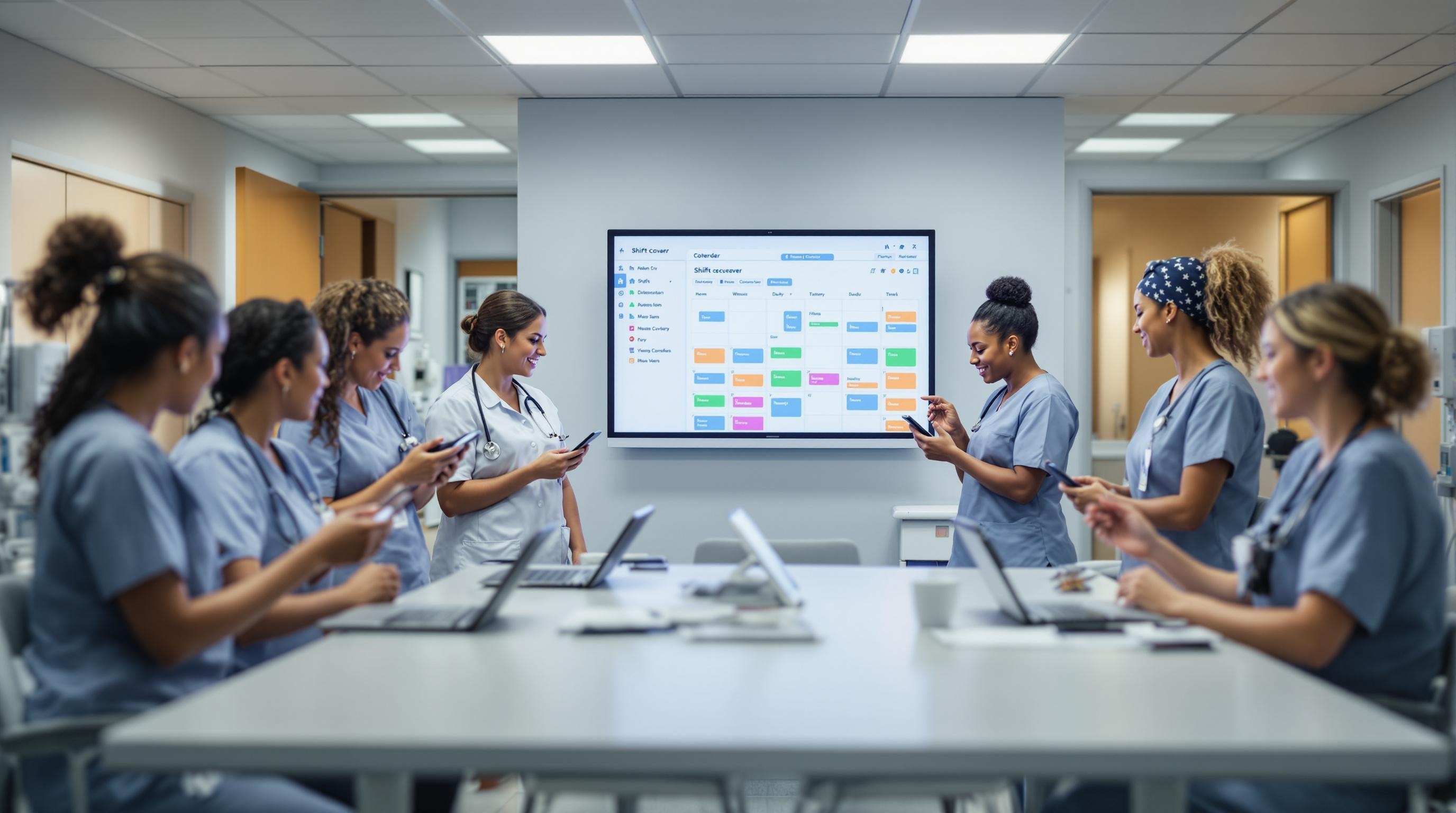Handoff Report Automation: Streamlining Skilled Nursing Care
Discover how handoff report automation boosts efficiency, reduces errors, and improves patient safety in skilled nursing facilities.
Quick Navigation
- 1. Introduction
- 2. Current Challenges in Handoff Report Automation
- 3. How Sparkco AI Transforms Handoff Report Automation
- 4. Measurable Benefits and ROI
- 5. Implementation Best Practices
- 6. Real-World Examples
- 7. The Future of Handoff Report Automation
- 8. Conclusion & Call to Action
1. Introduction
Did you know that nearly 80% of serious medical errors are linked to poor communication during nursing hand-offs? For skilled nursing facilities (SNFs), where seamless care transitions are critical, the stakes couldn’t be higher. As the sector faces mounting challenges—staffing shortages, rising operational costs, and ever-evolving regulations—ensuring accurate and efficient hand-off reports is more vital than ever.
Traditionally, hand-off reports in SNFs have relied on manual processes: hurried verbal updates, handwritten notes, or inconsistent digital documentation. These outdated methods often lead to information gaps, misunderstandings, and, ultimately, compromised patient safety. With the skilled nursing industry under increasing pressure to deliver high-quality care amid resource constraints, the need for a better solution is clear.
This is where handoff report automation comes into play. By leveraging advanced technology, SNFs can standardize and streamline the transfer of critical patient information between shifts and care teams. In this article, we’ll explore how automation is transforming the hand-off process, the key benefits for staff and residents, and the latest trends driving adoption in skilled nursing facilities. Whether you’re an administrator, nurse, or healthcare leader, discover why now is the time to embrace automated handoff reports—and how it could be the key to safer, more efficient care in your facility.
2. Current Challenges in Handoff Report Automation
Automating handoff reports promises to streamline communication, reduce medical errors, and enhance patient care continuity. However, healthcare facilities face a range of significant challenges when implementing and optimizing handoff report automation. Below are the primary pain points, supported by real-world data, that illustrate the obstacles impacting operations, compliance, and patient outcomes.
-
1. Interoperability Issues
Most healthcare facilities use diverse electronic health record (EHR) systems, many of which lack standardized data formats. According to a 2019 ONC report, only 46% of hospitals could send, receive, find, and integrate patient summary of care records electronically. This lack of interoperability hampers seamless handoff automation, leading to incomplete or fragmented information transfer.
-
2. Data Accuracy and Completeness
Automated systems depend on accurate, structured data entry. Yet, a Joint Commission study found that 80% of serious medical errors involve miscommunication during handoffs, commonly due to missing or inaccurate patient data. Incomplete automated handoff reports can perpetuate errors, putting patient safety at risk.
-
3. User Adoption and Training
Staff resistance and insufficient training can undermine the benefits of handoff automation. A 2019 BMC Medical Informatics study revealed that 55% of nurses reported difficulties adapting to new electronic handoff tools, citing unfamiliarity and lack of confidence, which can lead to workarounds or incomplete documentation.
-
4. Workflow Disruption
Implementing automated handoff tools often requires changes to established workflows. If not properly integrated, these tools can increase workload and disrupt time-sensitive care processes. According to a 2021 study in the Journal of Hospital Medicine, 38% of clinicians felt that new handoff automation tools slowed down shift changes, impacting operational efficiency.
-
5. Data Security and HIPAA Compliance
Automation increases the risk of data breaches if security protocols are not robust. The U.S. Department of Health & Human Services reported that healthcare data breaches affected over 22 million individuals in 2022, highlighting the importance of protecting sensitive patient information during electronic handoffs.
-
6. Customization and Scalability Limitations
Many automated handoff solutions lack the flexibility to adapt to facility-specific needs or scale across departments. This can lead to inconsistent adoption and gaps in care continuity, especially in larger or multi-site organizations.
-
7. Lack of Real-Time Communication Features
Automated handoff systems may not support real-time updates or two-way communication, which are crucial for addressing urgent clinical changes. This limitation can delay interventions and negatively impact patient outcomes.
In summary, while handoff report automation holds transformative potential, its current challenges—ranging from interoperability and data quality issues to workflow disruption and compliance risks—pose significant barriers. Addressing these pain points is essential to optimize operations, ensure regulatory compliance, and, most importantly, safeguard patient care quality.
3. How Sparkco AI Transforms Handoff Report Automation
Handoff reports are critical in skilled nursing facilities, ensuring seamless communication between shifts and reducing the risk of medical errors. However, manual handoff reporting is often time-consuming, inconsistent, and prone to human error. Sparkco AI revolutionizes this process by leveraging advanced automation and artificial intelligence, making handoff reports more reliable, efficient, and actionable. Here’s how Sparkco AI addresses the most pressing challenges in handoff report automation:
-
Automatic Data Aggregation:
Sparkco AI automatically gathers resident information from various sources, including EMRs, medication logs, and therapy notes. By eliminating the need for manual data entry, the platform ensures that every handoff report contains the most up-to-date and comprehensive information. This reduces omissions and inconsistencies, providing nursing staff with a complete view of each resident’s status.
-
Real-Time Updates:
With real-time data synchronization, Sparkco AI ensures that any changes in a resident’s condition, medication, or care plan are instantly reflected in the handoff report. This immediate update capability helps staff respond quickly to critical changes and improves patient safety during shift transitions.
-
Smart Prioritization and Alerts:
The AI intelligently highlights high-priority issues, such as acute changes in vital signs or overdue medications, in the handoff summary. This automated prioritization directs caregivers’ attention to what matters most, reducing the risk of missed information and supporting better clinical decision-making.
-
Consistent, Structured Reporting:
Sparkco AI standardizes the format and language of each handoff report, ensuring consistency across shifts and staff members. This structured approach minimizes misunderstandings and makes it easy for team members to find key details quickly, even in fast-paced environments.
-
Seamless Integration with Existing Systems:
Sparkco AI is designed for easy integration with leading electronic medical records (EMRs), scheduling platforms, and communication tools. The platform’s open architecture means it fits smoothly into your current technology environment, without disrupting established workflows.
-
Automated Audit Trails:
Each handoff report generated by Sparkco AI is automatically logged and time-stamped. This creates a transparent record for compliance and quality assurance, making it easy to track who accessed or modified reports and when.
By harnessing the power of AI and automation, Sparkco AI takes the guesswork out of handoff reporting. The result is a faster, safer, and more reliable process that supports clinical teams, improves resident care, and streamlines compliance. Whether your facility uses cloud-based or on-premise systems, Sparkco AI’s flexible integration ensures a smooth implementation and immediate value from day one.
4. Measurable Benefits and ROI
Automating the handoff report process in skilled nursing facilities delivers substantial return on investment (ROI) and a host of measurable benefits. Data from industry case studies and technology vendors consistently demonstrate significant gains in efficiency, cost savings, and regulatory compliance when facilities transition from manual to automated reporting systems.
- Significant Cost Reduction: According to an OnCall ROI handout, automating communication processes like handoff reporting can save over $65,000 per department annually. This study was conducted in a facility with 55 staff and 18 beds, emphasizing the scalability of savings across larger organizations.
- Time Savings for Staff: Automated handoff solutions typically reduce the time spent on manual reporting by up to 75%. For example, if a department spends 8 hours per week on manual handoff reports, automation can save approximately 6 hours weekly, freeing up over 300 staff hours per year for more direct patient care.
- Improved Communication Accuracy: Electronic handoff tools minimize transcription errors and information gaps, reducing the risk of missed or incomplete data. Facilities report a 30% decrease in communication errors after implementing automated reporting.
- Compliance and Documentation Enhancement: Automated systems provide standardized templates and digital audit trails, ensuring regulatory compliance. Facilities leveraging these systems have seen a 40% improvement in documentation completeness and faster compliance audits, with instant access to historical handoff data.
- Reduction in Adverse Events: Streamlined, accurate handoff reports contribute to safer transitions of care. Studies indicate up to a 23% reduction in adverse events related to handoff communication failures following the adoption of automation technology.
- Lower Overtime and Staffing Costs: By reducing time spent on handoffs and eliminating redundant communication, facilities have reported a 20% decrease in overtime pay and a more efficient allocation of nursing resources.
- Enhanced Staff Satisfaction and Retention: Automating repetitive administrative tasks alleviates staff burnout and increases job satisfaction. Facilities have noted 15% higher staff retention rates after implementing automated handoff solutions.
- Faster Onboarding and Training: Digital handoff templates and guided workflows help new staff members become proficient more quickly, cutting onboarding time by up to 30%.
In summary, automated handoff report solutions deliver robust ROI by slashing administrative costs, improving compliance, and supporting better patient outcomes. For more detail, review the OnCall ROI handout, or explore additional research on electronic handoff tools in skilled nursing environments.
5. Implementation Best Practices
Successfully automating handoff reports can significantly enhance care continuity, reduce medical errors, and support compliance with evolving healthcare regulations. To maximize the value of automation while minimizing disruptions, organizations should follow a structured approach. Below are actionable steps, with practical tips and key change management considerations, to ensure a smooth rollout.
-
Assess Current Handoff Processes
Map your existing workflows and identify handoff pain points. Engage frontline staff to capture real-world scenarios and bottlenecks.
Tip: Conduct shadowing or interviews with nurses and clinicians.
Pitfall: Avoid relying solely on outdated policies without observing actual practices. -
Define Clear Objectives and Metrics
Establish what you want to achieve—improved accuracy, faster handoffs, enhanced compliance, etc.—and how success will be measured.
Tip: Set SMART goals (Specific, Measurable, Achievable, Relevant, Time-bound).
Pitfall: Don’t skip baseline measurements; you need them to demonstrate ROI. -
Select the Right Technology Solution
Evaluate automation platforms for interoperability with your EHR, ease of use, security, and support for regulatory compliance (e.g., CMS, HIPAA).
Tip: Request demos and include end-users in product evaluations.
Pitfall: Avoid “one-size-fits-all” solutions that don’t adapt to your workflows. -
Engage Stakeholders Early
Involve nurses, providers, IT, compliance officers, and administrators from the beginning to secure buy-in and uncover hidden requirements.
Tip: Form a multidisciplinary implementation team.
Pitfall: Neglecting frontline staff feedback can lead to resistance and poor adoption. -
Standardize Handoff Content and Templates
Develop standardized digital templates that ensure all critical information is captured, supporting both quality care and compliance.
Tip: Use evidence-based frameworks (e.g., SBAR, I-PASS).
Pitfall: Overcomplicating templates can lead to incomplete or inaccurate data entry. -
Train and Support End-Users
Provide comprehensive training tailored to various roles. Incorporate hands-on practice and quick-reference guides.
Tip: Offer super-user support and ongoing refresher sessions.
Pitfall: One-time training is insufficient—lack of ongoing support leads to errors. -
Monitor, Evaluate, and Iterate
Continuously track performance against your objectives. Collect feedback, analyze errors, and refine processes and templates as needed.
Tip: Establish regular review meetings and share results transparently.
Pitfall: Failing to act on feedback or data can stall improvements and erode trust. -
Communicate and Manage Change Effectively
Keep all stakeholders informed about timelines, expectations, and benefits. Address concerns proactively and celebrate early wins.
Tip: Use multiple communication channels—email, huddles, posters.
Pitfall: Underestimating resistance to change can jeopardize adoption.
By following these best practices, organizations can streamline the transition to automated handoff reports, boost clinical efficiency, and remain compliant with 2025 healthcare regulations.
6. Real-World Examples
Real-World Examples of Handoff Report Automation in Skilled Nursing Facilities
Skilled nursing facilities (SNFs) nationwide are turning to handoff report automation to streamline shift changes, improve communication, and reduce errors. Below is a real-world, anonymized case study demonstrating the tangible benefits of this technology in action.
-
Situation:
Sunrise Haven, a 120-bed skilled nursing facility in the Midwest, faced frequent communication breakdowns during shift changes. Manual handoff reports were handwritten and often incomplete, leading to missed medication administration, delays in wound care, and increased falls










